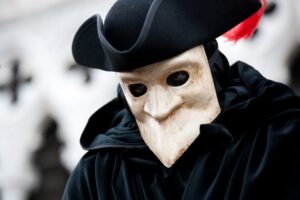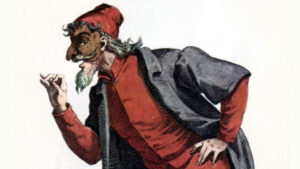The most popular traditional masks of the Venice Carnival
For centuries the Venice Carnival has been one of the most anticipated events of the year. Every winter, the city gets ready to welcome tourists (and not only) in the most festive atmosphere ever, with its colors, traditions, local sweets and, of course, masks.
A few words about its origins: the Venice Carnival was held for the first time in the second half of the 13th century and, since then, it has represented a celebration of freedom from societal roles, inhibitions and etiquette.
It’s exactly this need for relief and lightness that led to the tradition of wearing a mask as people still do these days. Masks and costumes guaranteed anonymity and mitigated social inequalities among different classes and religious groups.
Are you planning a stay in Venice? Take a look at our special offer dedicated to Carnival!
The Bàuta
Among the traditional Venetian masks, the Bàuta is certainly the best known, was it only for its over 500 years of history.
It is a white rectangular mask with a small protrusion instead of the mouth. This not only allowed the person wearing it to eat and drink without taking it off, but also created a small variation in the voice to further ensure anonymity.
This is usually accompanied by a cloak and the tricorn, the ancient three-pointed Venetian hat.

The Mattacino
It is one of the typical masks of the Venice Carnival that you will most easily meet: it is a kind of clown with a multicolored dress. They were once known for throwing scent-filled eggs to strangers, using a kind of slingshot.
The Moreta
The Moreta was the female mask par excellence. Its origins are actually French and it consists of a simple black velvet mask.
The peculiarity was that the woman had to support the mask by holding a button between her lips.
The Plague Doctor
A mask with a long pointed nose, similar to the beak of a bird, originally worn by doctors during plague epidemics to filter the air. Today it is one of the most recognizable masks during the Venice Carnival.
Thanks to the rich tradition of the Commedia dell’Arte (Italian theatrical form popular between the 16th and 18th century), masks and disguises that represented the stereotypes of the Venetian society of the time also became widespread.
Pantalone
Pantalone is probably the best known Venetian mask. It is characterized by its frank and musical Venetian speech. The etymological hypotheses on the origin of the name are different: it could derive from Saint Pantalone or from piantaleoni (lit. “lion-planters”), the name given to the merchants who started business in the conquered lands and symbolically “planted” the lion of San Marco.
Pantalone is an old merchant, often rich and esteemed, other times fallen into ruin. He embodied the mercantile ethics of the Venetian bourgeoisie which was beginning to impose its power among the ruling classes.
The costume consists of a Greek-style wool cap, a red jacket and sailor trousers. From the belt hangs a sword or a handkerchief or, sometimes, a bag. He wears a black cloak, often lined in red, and black slippers.

Arlecchino
It is the mask of the Commedia dell’Arte most connected to the people. The outfit consists of a jacket and trousers with very colorful and irregular patches, a white felt hat and a belt from which hangs the wooden spatula, normally used to mix polenta. On his face he wears a black half mask and he is a silly and somewhat gullible character.
Colombina
Colombina is Arlecchino’s favorite adventure companion (she is actually in love with him) and, like him, she finds her origins in popular tradition. Her distinctive traits, which always emerge also on stage, are cunning and flirtatiousness.
Her dress is simple, sometimes with colored patches like Arlecchino’s, and is finished with a white bonnet and an apron of the same color. She rarely wears a mask and expresses herself in various dialects, Venetian being one of her favorites.



